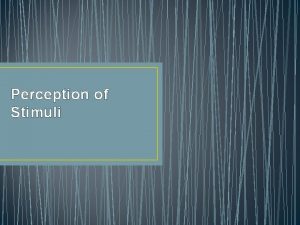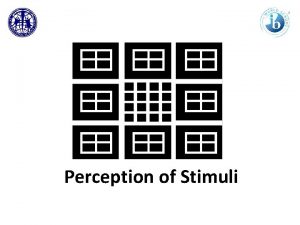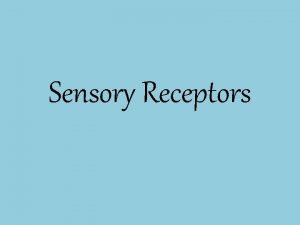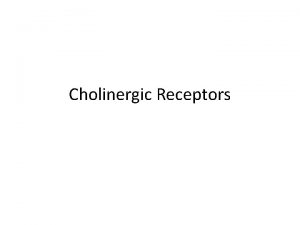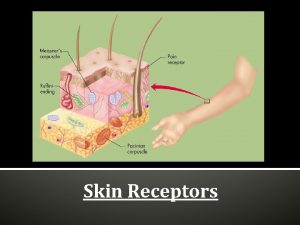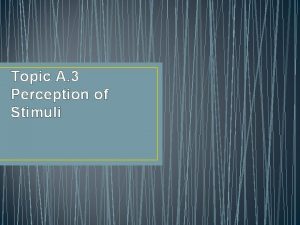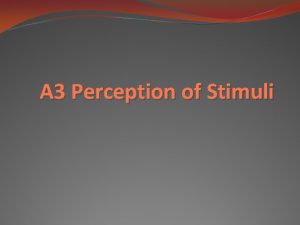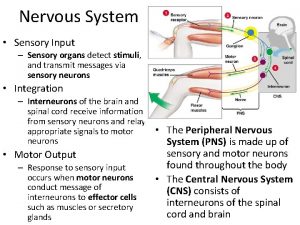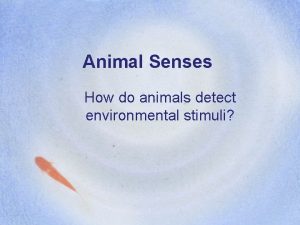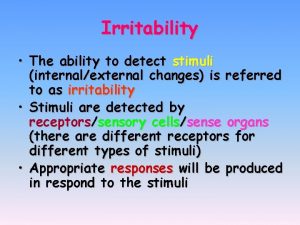A 3 Perception of Stimuli Understandings Receptors detect














- Slides: 14

A. 3 Perception of Stimuli

Understandings Receptors detect changes in the environment Rods and cones are photoreceptors located in the retina Rods and cones differ in their sensitivities to light intensities and wavelengths Bipolar cells send the impulses from the rods and cones to the ganglion cells Ganglion cells send messages to the brain via the optic nerve The information form the right field of vision from both eyes is sent to the left part of the visual cortex and vice versa Structures in the middle ear transmit and amplify sound Sensory hairs of the cochlea detect sounds of specific wavelengths Impulses caused by sound perception are transmitted to the brain via the auditory nerve Hairs in the semicircular canals detect movement of the head Application Red-green color blindness as a variant of normal trichromatic vision Detection of chemicals in the air by the many different olfactory receptors use of cochlear implants by deaf patients Skill Labelling a diagram of the structure of the human eye Annotation of a diagram of the retina to show the cell types and the direction in which light moves Labelling a diagram of the structure of the human ear

Mechanoreceptors Stimulation: mechanical force (pressure) Sense of touch pressure sensors on skin Arteries pressure receptors detect change in blood pressure Lungs stretch receptors respond to lung inflation Position of legs/arms proprioceptors (muscle fiber, tendons, joints, ligaments) Help maintain posture and balance Ear: pressure receptors – information about equilibrium

Chemoreceptors Taste and Smell Response to chemical substances Provide information about internal body environment Blood vessels monitor p. H changes which adjusts breathing rates Pain receptors respond to chemicals released by damaged tissue

Thermoreceptors Respond to change in temperature

Ciliary body Suspensory pigment Iris: regulates the size of the pupil Anterior humuor: transmit light rays, supports eyeball Lens: focuses light rays Cornea: focusing begins here Posterior humuor Optic nerve: transmit impulses to the brain Fovea: densely packed cone cells, most acute vision Sclera: protects, supports eyeball Choroid: absorbs stray light Conjunctiva: covers sclera/cornea, keeps eye moist Retina: contains photorecepotrs


Rods and Cones Rods Cones More sensitive to light (function well in dim light) Less sensitive to light (function well in bright light) Only 1 type found in retina: it can absorb all wavelengths of visible light 3 types found in retina: 1 – sensitive to red light, 1 – to blue, 1 – green Impulses from group of rod cells pass to single Impulse from single cone cell passes to single nerve fiber Dichromatic Red blindness – presence of blue/green cones Green blindness – presence of red/green cones Variations lead to range of color-blindness Trichromatic


Stapes (stirrup) Incus (anvil) Malleus (hammer) Semicircular canal Pinna Tympanic membrane cochlea Cochlea nerve Oval window Round window Auditory canal Auditory tube

3. Bones (malleus, incus, stapes) receive vibrations from tympanic membrane, multiply 20 x 2. Travel down auditory canal, causing ear drum (tympanic membrane) to move back and forth 1. Outer ear = catches sounds waves 8. Wave in fluid dissipates as it reaches round window 7. 4. Stapes strikes oval window, causing vibration 5. Vibration passed to fluid in cochlea 6. Fluid causes special cells (hair cells) to vibrate Hair cells (receptors) release chemical message across synapse to sensory neuron of auditory nerve, moves to brain

High/loud frequency too often kills hair cells do not grow back Detect sounds of specific wavelength Bend back and forth internal change electrical impulse carried by auditory nerve Short, high frequency waves = high pitch sounds Long, low-frequency waves = low pitch sounds Cerebral cortex

Semicircular canals Control our equilibrium Contain fluid and hair cells Detects rotational movement of head Send message via vestibular nerve

External processor digitizes sound – transfers electrical signal to implant – surgically placed in cochlear External processor behind the ear Microphone picks up sound signal Implant deciphers digitized sound and transfers into electric signal Auditory nerve sends electric signal to brain Brain interprets sound
 Ubd essential questions
Ubd essential questions Aqa 8062
Aqa 8062 Topical essential questions
Topical essential questions Detect protect perfect
Detect protect perfect Detect protect perfect
Detect protect perfect Detect bad neighbor vulnerability
Detect bad neighbor vulnerability Detect font
Detect font Fffcd
Fffcd How are indicators used to detect macromolecules?
How are indicators used to detect macromolecules? Omitted variable bias
Omitted variable bias Kerberos golden ticket detection
Kerberos golden ticket detection Simple parity check code
Simple parity check code Detect study
Detect study To detect the presence of adulterants in sugar project
To detect the presence of adulterants in sugar project Detect hex color from image
Detect hex color from image















